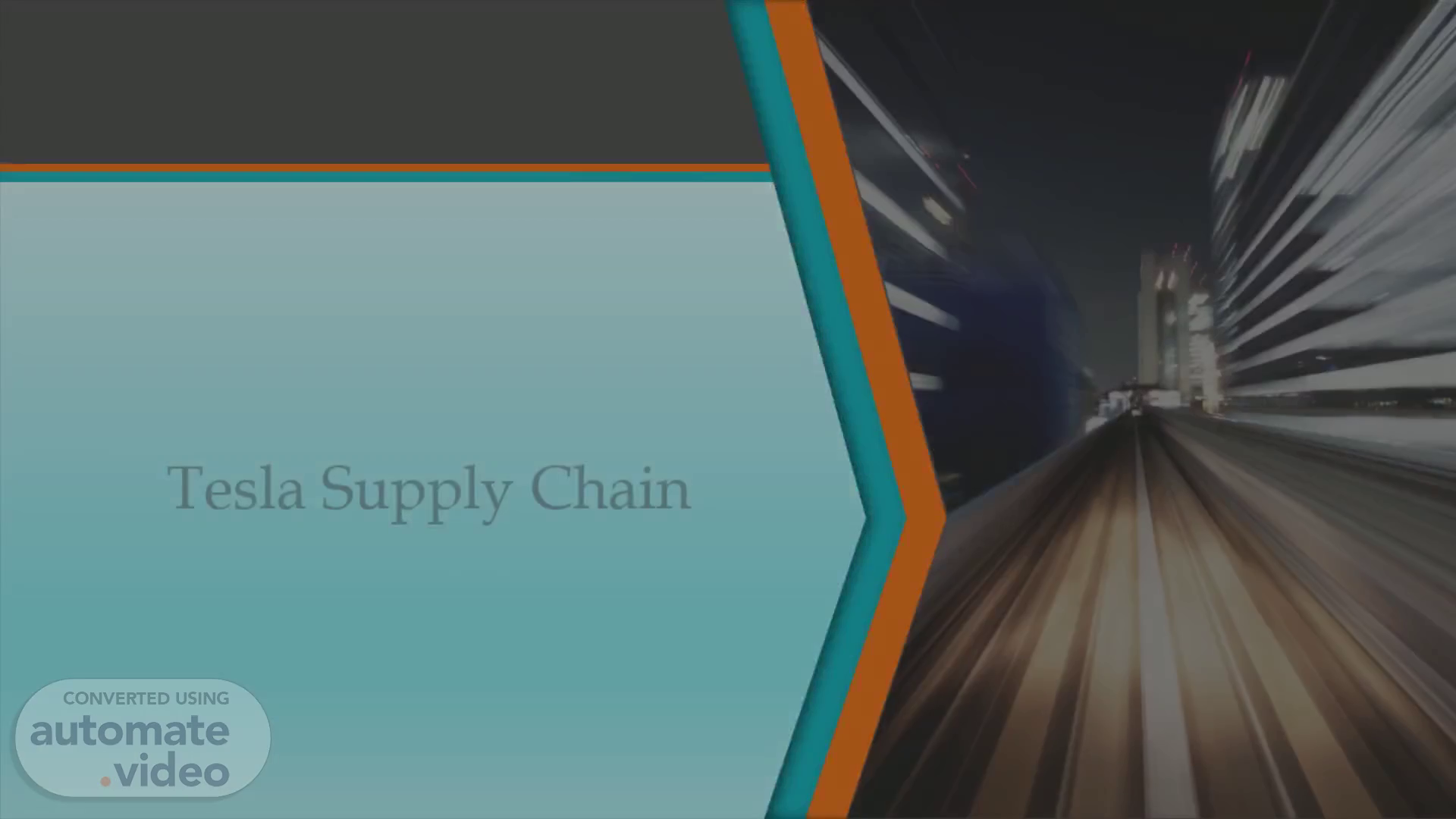Scene 1 (0s)
Tesla Supply Chain. City street with motion blur.
Scene 2 (7s)
[Audio] Tesla Inc. is one of the leading manufacturers of electric vehicles, battery cells and energy solutions. The core of the technologies exploited by Tesla is Lithium-based cells and the organization has direct ties with lithium producers in different parts of the world..
Scene 3 (32s)
[Audio] To create a resilient supply chain, the organization is committed to creating long-lasting connections with its suppliers. Currently, 40% of suppliers are situated in the US, while 30% are in China, Japan, and Switzerland ( Wu and Yang, 2017). The remaining Tesla suppliers are dispersed around the globe (mainly Africa and Asia). Tesla makes an effort to compel its partners to adopt sustainable practices, and it frequently qualifies some of them by requiring certification (Wu and Yang, 2017). The company has set specific procedures that suppliers must follow in order to meet strict requirements for labor force and environmental considerations.With no wholesalers and direct sales to clients, Tesla adopts a Silicon Valley distribution strategy..
Scene 4 (1m 25s)
[Audio] The automobile sector suffered as a result of the lockdowns that many nations implemented in reaction to the outbreak. The interruptions in the lithium supply turned out to be particularly dangerous for the manufacture of electric vehicles. Because lithium suppliers had to stop production and needed time to resume it, the auto industry and battery makers were unable to meet the demand. Researchers emphasize that additional time will be needed to address the effects of lockdowns because the business has not yet recovered ( Cavaliere, 2021). While the supplies of other minerals were also compromised, the sector was not negatively impacted by the resulting supply interruptions..
Scene 5 (2m 8s)
Block Chain Technology. Blockchain is a distributed ledger, or database shared across a public or private computing network. The technology negates the role of a central authority to verify transactions between two or more parties to avoid double spending. Blockchain technology has multiple potential applications in the energy sector from tracking of electrons to processing of payments. Given that the benefit of increased adoption of Electric Vehicles (EV) will be compounded if the source of electricity used for charging is clean, the application of blockchain in the sector becomes even more crucial..
Scene 6 (2m 34s)
Block Chain Technology. This technology focuses on transparency and reliability. This technology is favorable to electric vehicle manufacturers because it can optimize inventory flow. Blockchain technology is instrumental in building networks of reliable multi-tier suppliers and partners..
Scene 7 (2m 47s)
[Audio] The usage of different software tools, such as simulations or decision-making aids, is advantageous to the automobile sector as well ( Gianesello, Ivanov and Battini, 2017). For example, managers frequently attempt to estimate resource availability and potential interruptions. Companies can pick from a range of applications for communication. To guarantee that internal communication is secure, they deploy corporate information systems ( Raj Kumar Reddy et al., 2021). Safe channels and corporate information systems are also used to communicate with partners. To control the movement of their goods, businesses must have access to specific databases and information systems. In the post-COVID corporate environment, it is clear that the immediate exchange of data is essential..
Scene 8 (3m 43s)
[Audio] The current state of battery manufacture serves as an example of how supply chain management is severely hampered by interruptions in the flow of materials and resources. Due to the lithium scarcity, businesses have experienced delays and are unable to meet market demand ( Cavaliere, 2021). Between 2020 and 2021, the sector experienced a number of shocks connected to the upkeep of appropriate contact and communication patterns with partners. Although there has been a slow rebound, many suppliers have departed the market, forcing automakers to forge new business relationships..
Scene 9 (4m 22s)
Analysis of the Solution. Can utilize diverse assessment instruments. A balanced score card can be used to check whether the solution will be able to improve the supply chain. The measurement will help identify weaknesses in the supply chain to improve it functioning. The focus is on such areas as financial performance and customer service..
Scene 10 (4m 40s)
Analysis of the solution. The company’s will develop close relationship with multiple suppliers across the globe to reduce costs and ensure undisrupted delivery of vehicles and inventory. Having different locations is a strategy that will reduce costs. More focus on innovations will help improve on the batteries capacity and reduce the vehicles price to have a much larger market..
Scene 11 (4m 58s)
[Audio] Tesla has to put a variety of plans into action to remedy the flaws in the current supply chain. Although effective, stakeholder participation in supply chain operations might be enhanced. In order to avoid interruptions and cut costs, which are crucial objectives for the company's success, more vertical integration is needed ( Pearce II, Robinson and Mital, 2018). To assure the development of the required technologies and methodologies, further investments in innovations will be required..
Scene 12 (5m 32s)
References.. Gianesello , P., Ivanov, D. and Battini , D. (2017) ‘Developing a blockchain framework for the automotive supply chain: a systematic review’, International Journal of Inventory Research, 4(4), pp. 257-280. Naor , M., Coman , A., and Wiznizer , A. (2021) ‘Vertically integrated supply chain of batteries, electric vehicles, and charging infrastructure: a review of three milestone projects from theory of constraints perspective’, Sustainability, 13, 1-21. Tesla. (2021) About Tesla. Pearce II, J. A., Robinson, R. B. and Mital , A. (2018) Strategic management: planning for domestic and global competition. 14th edn . New York, NY: McGraw-Hill Education..
